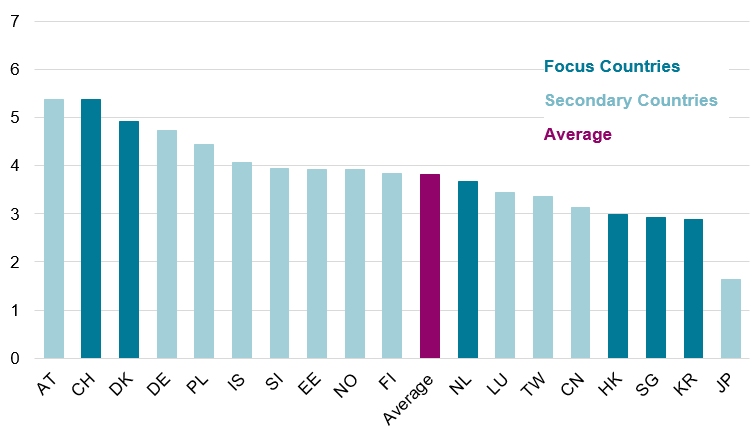Countries’ KOF EELI scores
This is the second in a three-part series on the KOF education-employment linkage index (KOF EELI). In Entry 1, I define education-employment linkage and the KOF EELI, which we developed to measure linkage. This entry is about the international KOF EELI comparison, and the next will cover the KOF EELI in the American state of Colorado.
By Katie Caves
Our lab used the index to assess 18 countries’ largest upper-secondary vocational education and training (VET) programs. Based on those outcomes we found the best performers, explored how scores arise from different program types, and identified some of the main features of top-performing VET programs.
Who did we measure and what were the scores?
The 18 countries we measured are all top-performers. Half have the best youth labor market situations in the world—among countries where data is available—and half have the best PISA scores in the world. That way we can capture strong VET systems by their outcomes—youth labor markets—and inputs—strong primary and lower-secondary education systems. Six countries—Switzerland, Denmark, the Netherlands, Hong Kong, Singapore, and South Korea—are selected as focus countries because they are the top three from each category. We collected many KOF EELI survey responses for these countries, and only one or two for the non-focus countries. Therefore, we can interpret a lot more about the focus countries. The scoreboard is shown in Figure 1, and you can find country abbreviations in the report.
Figure 1: KOF EELI Scoreboard
The best of the focus countries are Switzerland and Denmark, with the Netherlands near the average and the bottom made up of Hong Kong, Singapore, and South Korea. It’s already clear that the countries selected for their strong youth labor markets have higher education-employment linkage in VET, and those selected for high PISA scores have lower education-employment linkage.
It’s also the case that VET is much more common in the higher-scoring countries, with 45-73% of young people pursuing VET in the higher-performing countries compared to only 7-18% in the less-linked systems (this doesn’t include Singapore because its most common VET pathway isn’t at the secondary level). There is almost certainly a two-way causality here: students are unlikely to choose weak programs which would keep them small, and small programs are unlikely to attract the industry partnership that would make them stronger and more attractive.
Understanding the different programs
Part of the report was in-depth case studies of each focus country. If we’re going to interpret countries’ detailed KOF EELI scores—the index goes down to the phase, process, and feature level below the final score—we need to understand the programs and broader education systems we’re discussing. We describe the stakeholders involved in each VET program and their various roles, which helps us explain where the strengths and weaknesses of each system come from. For example, Denmark’s Erhvervsuddannelse (EUD) program has exceptionally strong infrastructure for cooperation built into its curriculum design process, which helps it score very high. In contrast, Hong Kong’s Diploma of Vocational Education (DVE) has many advisory and supporting committees representing multiple stakeholder perspectives, but because none have specific power in curriculum design the KOF EELI score is still low.
Weighting: What really matters?
Probably my favorite part about the KOF EELI is that we managed to build it to evaluate how important our respondents think each aspect of linkage is and create weights for each feature, process, and phase. Just building the index was a challenging process—we didn’t know how it would look or even if we could make something that made sense—so adding this detail is especially exciting. We regressed respondents’ impressions of linkage in a phase or overall with their scores for the features, processes, and phases that make up the index. As a result, we know what they consider important and irrelevant for “real” linkage and we can include that in the index. Happily, the weights are remarkably consistent across countries.
There are four aspects of education-employment linkage that turn out to be exceptionally important. They are:
- Employers are heavily involved in:
- Setting content standards
- Deciding when to update the curriculum
- Choosing how to test students’ mastery of the curriculum
- Students spend most of their time in the workplace instead of the classroom
According to the multiple hundreds of experts we surveyed in 18 countries, those are the most important parts of strong VET programs.
There are also a few characteristics that do not seem to matter at all. These include things like employers giving equipment to schools, regulations about who workplace trainers should be and how they should be certified, and the education system paying for part of workplace training. We can’t be too absolute about interpreting this because it might come from other characteristics essentially stealing their thunder, but these features and processes are very likely to be totally unhelpful for increasing education-employment linkage even though they seem reasonable.
This is why the weighting system is so cool: it lets us see which things really matter and which don’t, which can in turn help us make recommendations to systems that want to improve their level of linkage. Focusing on the four characteristics outlined above will help improve linkage. Avoiding the traps of the many unimportant characteristics that seem important will help reformers stay efficient.

